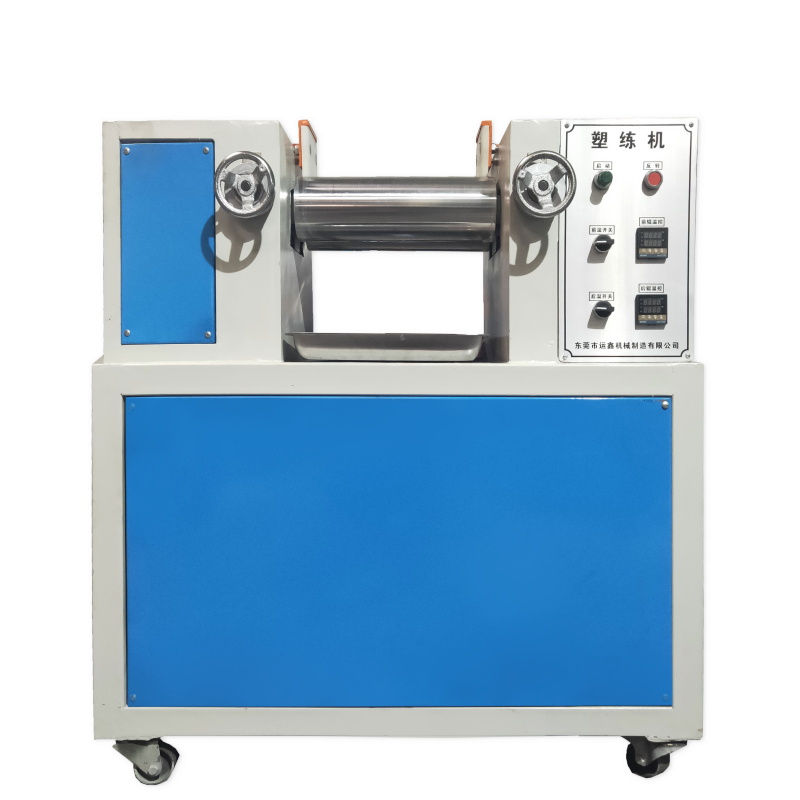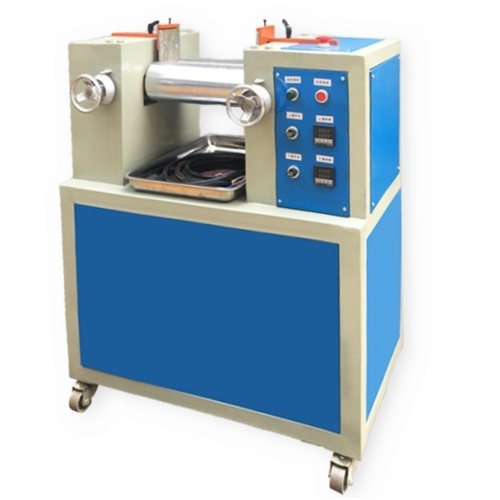
Rubber Mixing Mills are powered by electric motors and equipped with complex drive systems to control the speed and direction of the rolls. This enables precise control over the mixing process. If you want to know more, you can consult the Rubber Mixing Machine manufacturer.
 Rubber Mixing Mills typically have two rolls that rotate in opposite directions. These rolls are made of heavy-duty materials like cast iron or steel and are usually hollow to allow for efficient cooling and heating. They have a specialized surface pattern to aid in the mixing process. The space between the two rolls is called the mixing chamber. This is where the rubber compound is processed. The size of the chamber and the gap between the rolls can be adjusted to control the processing parameters. Rubber mixing mills are powered by electric motors and equipped with complex drive systems to control the speed and direction of the rolls. This enables precise control over the mixing process.
Rubber Mixing Mills typically have two rolls that rotate in opposite directions. These rolls are made of heavy-duty materials like cast iron or steel and are usually hollow to allow for efficient cooling and heating. They have a specialized surface pattern to aid in the mixing process. The space between the two rolls is called the mixing chamber. This is where the rubber compound is processed. The size of the chamber and the gap between the rolls can be adjusted to control the processing parameters. Rubber mixing mills are powered by electric motors and equipped with complex drive systems to control the speed and direction of the rolls. This enables precise control over the mixing process.
1.High hardness chrome-plated roller :roller is made of high strength steel, which is processed by quenching - outer circular grinding - electroplating hard chromium - outer circular grinding - mirror polishing, so that it does not stick, does not delamination, does not deformation, and never rust.
2.The safety device can be touched to stop immediately:Multiple touch-type emergency stoppers to avoid employees being mistakenly brought into the roller during work
3.Well-known brand parts:Imported high-quality steel to manufacture bidirectional plain bearings with high precision, low friction, can withstand radial and thrust loads at the same time, after layer treatment more wear-resistant, service life can reach more than 30 years.
Model | YX-SL120 |
Diameter of Roll(mm) | 110mm |
Length of Roll(mm) | 360mm |
Maximum roll distance(mm) | 6mm |
Single feed | Within 1KG |
Power | 0.75KW |
Rotation Speed of Front Roll(rpm) | 16r/min |
Roll speed pattern | Constant speed (adjustable speed/double adjustable speed) |
Bearing situation | Insert bearing |
Reducer casing | planet-gear speed reducer |
Voltage | 380V |
Weight | 200KG |
Dimension(L*W*H) | 850*550*1100mm |
Essential details | |||
Diameter of Roll(mm) | 120 mm, 110mm | Warranty | 1 Year |
Rotation Speed of Front Roll(rpm) | 1 - 16 rpm, 16r/min | Key Selling Points | Long Service Life |
Length of Roll(mm) | 360 mm, 360mm | Power (kW) | 0.75 |
Roll Ratio(Front/Back) | 01:01.3 | Weight (KG) | 200 KG |
Video outgoing-inspection | Provided | Applicable Industries | Manufacturing Plant, Machinery Repair Shops, Food & Beverage Factory |
Machinery Test Report | Provided | Showroom Location | None |
Warranty of core components | 3 years | Model | YX-SL120 |
Core Components | Motor | Maximum roll distance(mm) | 6mm |
Cooling Mode | water cooling | Single feed | Within 1KG |
Condition | New | Power | 0.75KW |
Place of Origin | Guangdong, China | Roll speed pattern | Constant speed (adjustable speed/double adjustable speed) |
Voltage | A.C.380V 50HZ | Bearing situation | Insert bearing |
Dimension(L*W*H) | 850*550*1100(mm) | Reducer casing | planet-gear speed reducer |
Year | 2020 | ||
Modern Rubber Mixing Mill
Since the rubber compound can generate heat due to the mechanical work done during mixing, cooling systems (usually water-based) are incorporated into the mill to prevent overheating and maintain the desired temperature. Additionally, some mills also have heating capabilities to aid in the processing of certain types of rubber compounds. Rubber mixing mills are equipped with various safety features, such as emergency stop buttons, guards, and interlock systems, to ensure the safety of operators. Rubber mixing mills are often used for batch processing, where a specific amount of rubber and additives are loaded into the mixing chamber, processed, and then removed for further processing or forming. Rubber mixing mills come in various sizes and configurations, catering to different production requirements. The choice of mill depends on factors such as the type of rubber being processed, production volume, desired properties of the final product, and available space in the manufacturing facility.
Rubber Kneader Machine Price
Basic entry-levelrubber kneader machines with smaller capacities might start from a few thousand dollars, while larger and more advanced models with higher capacities, additional features, and better build quality can cost tens of thousands of dollars or even more. Industrial-grade machines with high capacities and specialized features could have even higher price tags. Our company produces in batches and has a large number of spot goods. The manufacturers sell directly to all parts of the country, and some are exported to Southeast Asia, Europe, Africa and other parts of the world. You can consult us for quotations. Additionally, factors such as location, shipping costs, and any customization you might require can also influence the final price of the machine.
FAQ
What should I do if the drum does not rotate after the equipment is started?
Possible reasons:
The power connection is abnormal, check whether the power supply is normal.
The motor or transmission system fails, check whether the motor is damaged or the belt is loose.
The safety protection device is triggered, check whether the emergency stop button is pressed.
What should I do if the rubber material is unevenly distributed during mixing?
Possible reasons:
The roller gap is improperly adjusted, try to adjust the gap to ensure uniform mixing.
The plasticity of the raw materials is not good, and the formula needs to be adjusted or the raw materials need to be preheated.
The operating speed is too fast, and the drum speed should be appropriately reduced.
How to deal with abnormal noise during equipment operation?
Possible reasons:
The bearings or gears are worn, and the worn parts need to be checked and replaced.
Insufficient lubrication, add lubricating oil regularly.
The equipment is loose, check and tighten the bolts of each component.
What should I do if the drum temperature is too high or too low?
Possible reasons:
The cooling system fails, check whether the cooling water or oil circulation is normal.
Overload operation, reduce the load or adjust the operating parameters.
The heating system is abnormal, check whether the heating element is damaged.
What should I do if the rubber sticks to the roller?
Possible reasons
The oil content of the mixing formula is too high, adjust the formula ratio.
The surface temperature of the roller is too high or too low, adjust the temperature appropriately.
There is residue on the surface of the roller, clean the roller and keep it clean.
How to solve the roller wear after the equipment has been used for a period of time?
Possible reasons:
Long-term high-load operation, it is recommended to arrange the use time reasonably.
Improper material selection, use wear-resistant material rollers.
Regular maintenance to ensure that the roller surface is smooth and undamaged.
What should I do if the equipment cannot adjust the roller gap?
Possible reasons:
The adjustment mechanism is stuck, check whether the screw or hydraulic system is normal.
The roller is damaged or worn severely and needs to be repaired or replaced.
How to maintain the machine after use?
Suggestions:
Check the lubrication system regularly to ensure that all parts are well lubricated.
Clean the roller and working area to prevent residual rubber from affecting use.
Check the electrical system to ensure safe operation.